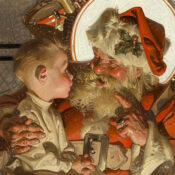For centuries, the poster has been a useful tool for advertising coming attractions, warning of dangers both physical and spiritual, and publicly calling for political change. But it wasn’t until the 1960s that the idea of using posters for decoration really took off. For just a few bucks, a young person could instantly change the entire mood of a bedroom as political ideals shifted, new rock ’n’ roll bands came to prominence, or new social causes found footholds.
As Herbert Gold discovered in 1968, the poster makers of San Francisco would say their posters were an art, not a business. Yes, but they were a business, too, and a lucrative one at that. Gold’s March 23, 1968, Post article “Pop Goes the Poster” gives readers a closer look at the artists, artistry, and commerce of 1960s poster art.
Interspersed with that article are examples of some of the eye-catching psychedelic posters of the time that are featured in the exhibit “The Summer of Love Experience: Art, Fashion, and Rock & Roll” on display through August 20, 2017, at San Francisco’s De Young Museum.
Pop Goes the Poster
By Herbert Gold
Originally published March 23, 1968
Freaky, funny, and fashionable, these are the signs of our times
Sätty, the experimenter in poster art, is talking. “I am only on the first or second step of two hundred.” Modestly he lowers his eyes. “Others must carry on my work. I need to communicate with others — a hundred million people in this country under 25.”
He lives with his wife in a white and airy apartment overlooking the San Francisco Bay. He meditates and creates in an underground North Beach studio with incense, alcohol flames, rock music, a collection of clocks, a sort of altar, and a bed under a concrete stairway, surrounded by mirrors. As a child in Germany, he was shuttled back and forth under the bombs. He says he has a piece of shrapnel in his head and sometimes wears an eye patch. There is pressure on his nerves.
The San Francisco poster makers — Sätty, Paul Olsen, Wes Wilson, Mouse, Victor Moscoso, and a dozen or so active others — may look like flower children, but their passion has become a mini-industry. Wes Wilson’s early posters sold over 300,000 copies in the first months of the craze. Companies like East Totem West, Funky Features, Astro, The Food, Sparta, and American Newsrepeat use jobbers and wholesaling agencies.
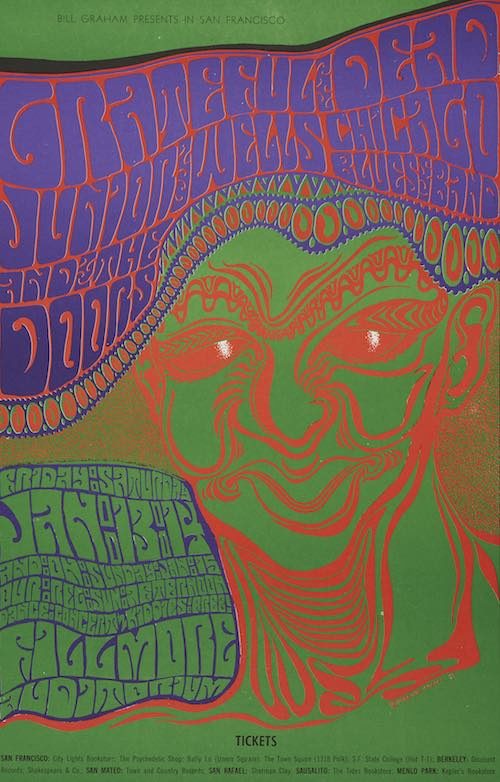
What does this mean in financial terms? Well, say the poster makers, it’s an art, not a business. Yes, but it’s a business, too. “Half the population is under 25.”
Take the Haight-Ashbury poster, because it’s a sort of business, even the art people will admit. It’s a photo of Haight-Ashbury street signs fuzzed up and flowered up to look dreamy. It has sold about 80,000 copies at two dollars each. Profit? Well, the profit is shared among designer, producer, jobber, seller, but the producer alone has made about $40,000. It’s a friendly, flowery souvenir of the Haight. After which, perhaps, aesthetic criticism is in order.
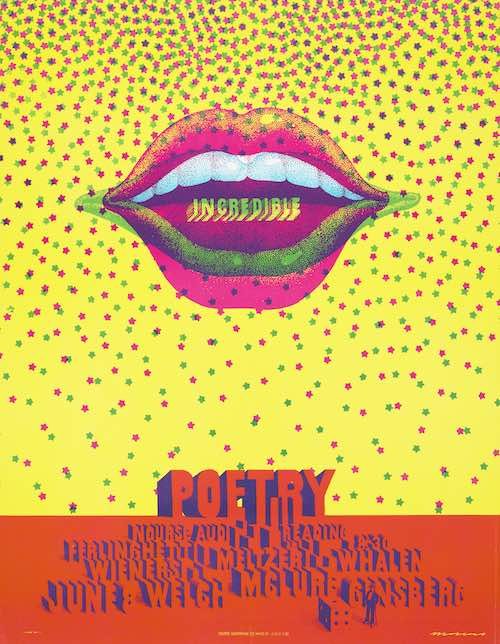
“Which do you like best?” asked an indulgent daddy of his high-school daughter, touring the hip-life with him.
“The one with the American flag and the leaves.”
“Yes, that’s nice,” said Daddy, and to the salesman, “Roll it up for me, please.”
The salesman beamed. “Do you know what these leaves are?”
The girl winked. “Aw,” she said, “Sure. Pot.”

Sätty, formerly an industrial designer, is one of the most passionately experimental and daring artists, hiring presses to do overprinting and improvisational exercises — printing a visual equivalent of rock sound. He superimposes one poster on another to make collages of color, shape, and idea. He’s doing his thing, creating the moving wall, the disposable environment.
In Paris, 20 years ago, Raymond Duncan, an old-time Bohemian in Greek robes, said, “You want to paint? Show it on walls. Paste and pin it. Want to be a poet? Commit poetry on the walls.” He is the unacknowledged prophet of the San Francisco artists, Mouse and Wes Wilson, who pioneered the revival of poster art a few years ago. They did not invent it: Toulouse-Lautrec and Cro-Magnon Man got there ahead of them. But today, for job-shifting, house-changing, marriage-altering youth, this art which is immediate, impermanent, expressive, and neat has a powerful appeal. It’s like having a continuous movie on the walls. And the mood can be changed for a couple of bucks, from politics (anti-Johnson, anti-war, anti-cops, pro-love) to astrology to fan worship (Brando, Joan Baez, Bob Dylan, Che Guevara) to rock dance-band announcements to souvenirs of times and places to, well, pure art.
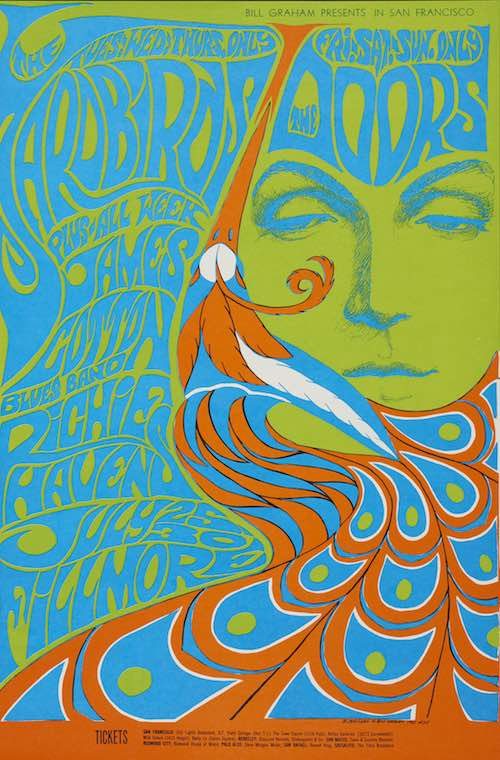

American Newsrepeat Co. is into good deals. A former manager of an improvisational-theater group and a former dress-factory superintendent decided that politics, smoking, peace, drugs and enlarged belly buttons might come to express a way of life. Join — a bulbous-nosed old man dressed as Uncle Sam, pointing a finger — has sold hundreds to soldiers in Vietnam, thousands to bases in the U.S., 50,000 in all. Join the Army, a picture of a company of over a hundred hippies, is doing brisk business. Hallelujah the Pill and Better Living Through Chemistry have enjoyed academic approval; planned-parenthood clinics have taken them seriously, and they are appearing in textbooks. Let Us Be Clear is a philosophic poster which they have made to be given away. They are also doing a No Smoking poster, to be given free. “We made IS because it looked nice. People buy it and then they write to us and ask what it is. We say. ‘It is.’ You see, it’s a total affirmation of the present.” IS is a poster with just a large “IS” printed on it.
Funky Jack Leahy is a Princeton dropout of good family in Palo Alto. Funky Sam Ridge is a former law student, disk jockey, TV cowboy, and administrative assistant to Assemblyman John Burton. Funky Paul Olsen is a squeaky-voiced retired college student who did pop and op art and, at age 24, was developing a small following among Bay Area art collectors. These three met at a gathering of the Artists Liberation Front, a short-lived Bay Area organization, and got to talking about how dance posters were giving way to art, how visual rock ’n’ roll was the thing.
And so Funky Features was born. The company is not the biggest of the poster producers, but it grosses $25,000 a month. Jack, Sam and Paul have a fleet of delivery trucks — the Batmobile, the U.S. Grape truck, Sam’s vintage Mercedes, Paul’s junky Jag, Jack’s MG, plus the girl friends’ sports cars and some miscellaneous psychedelic vehicles that weave their way from a Haight-Ashbury warehouse to downtown shops and onward.

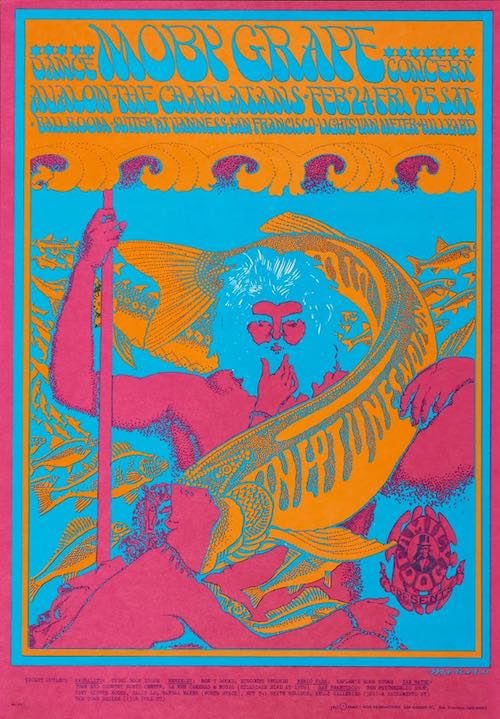
Sam Ridge of Funky Features has put 20,000 miles on his car in the past few months, crisscrossing the country to bring the real poster product to places where only plastic art was known before. To the Mole Hole in Chicago, the Infinite Poster and the Intergalactic Trading Post and Underground Uplift Unlimited in New York, the Kazoo in Los Angeles, George’s Folly and Truc in Boston, Head Shop South in Coconut Grove, Florida, the Emporium in Miami Beach, to shops in college towns and semi-college towns all over the Midwest. … In walks Funky Sam with boots, beard, and candy-striped pants, saying, “I’m the only man over 30 the kids can trust. Now I don’t sell W.C. Fields Personality Posters — for that you have to go to Martin Geisler in New York — and I don’t sell plastic hippie stuff either — I’m a-selling of that good old rock baroque, I’m selling pretties and meanings, it’s the psychedelic cultural revolution. We bill on the tenth of the month. I’m here to work for the common evil, brothers. Oh yea, if you want political posters, there’s Dick Kasak in New York, too. You’ll note our Zodiac line — well, we’re not greed heads. We turned down huge orders from J.C. Penney’s and Woolworth’s. They wanted to cover certain parts of anatomies, tame our artists. Nyet. This is Obscenity Junction where we bend your minds. Here’s our folding display. …”
Well, maybe he doesn’t say all that right off. But that’s his general approach. And Funky Features is now a successful small business. These crazy hippies, it seems, don’t need to work for the “establishment.” The total volume in posters is now perhaps $2 million a year and involves record companies, chain stores, printers, painters, book-card-ye-gift shops.
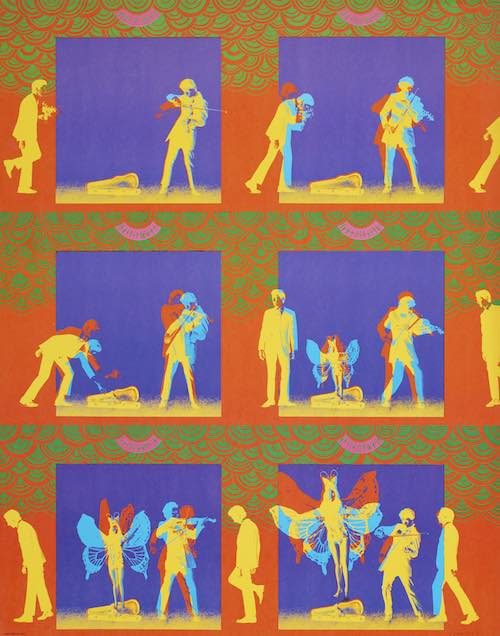

So whatever happened to the bullfight poster? Manolete with glue on his back is out, man. It’s the Jefferson Airplane now, and A Day in the Life, and the marijuana warning, and the Do It to Communism banner. Each semester brings a flood of new poster-buyers into the dormitories, believing in the Zodiac and Che Guevara. Poster is son of button, big brother of the bumper sticker, weird indoor step-cousin of the billboard, teeny-bopper daughter of the painting, city-slicker cousin of the print. And a sparkling orphan prince all by itself.
The poster makers of San Francisco have a mystical sense of mission (and perhaps cash, too). They recall that Mount Tamalpais was the magic mountain for the Indians, and the beatnik and hippie movements knew their finest flowering in the blue-and-white watery city by the bay. San Francisco Rock is the Acapulco gold of rock ’n’ roll. San Francisco posters, the Nouveau Frisco style and its offshoots, are the vanguard of the poster art.
Funky Paul has just designed the poster that may turn out to be the superposter of all time. When you study it carefully, you find the design stating, in psychedelic lettering, with involuted, drug-free, mystical, shock-rock whorls of color: “THIS POSTER SELLS FOR TWO DOLLARS.”
If you happen to be a wholesome American consumer under 25, you’ll love it, he says. And there are a hundred million of you.

This article is featured in the July/August 2017 issue of The Saturday Evening Post. Subscribe to the magazine for more art, inspiring stories, fiction, humor, and features from our archives.
Become a Saturday Evening Post member and enjoy unlimited access. Subscribe now



